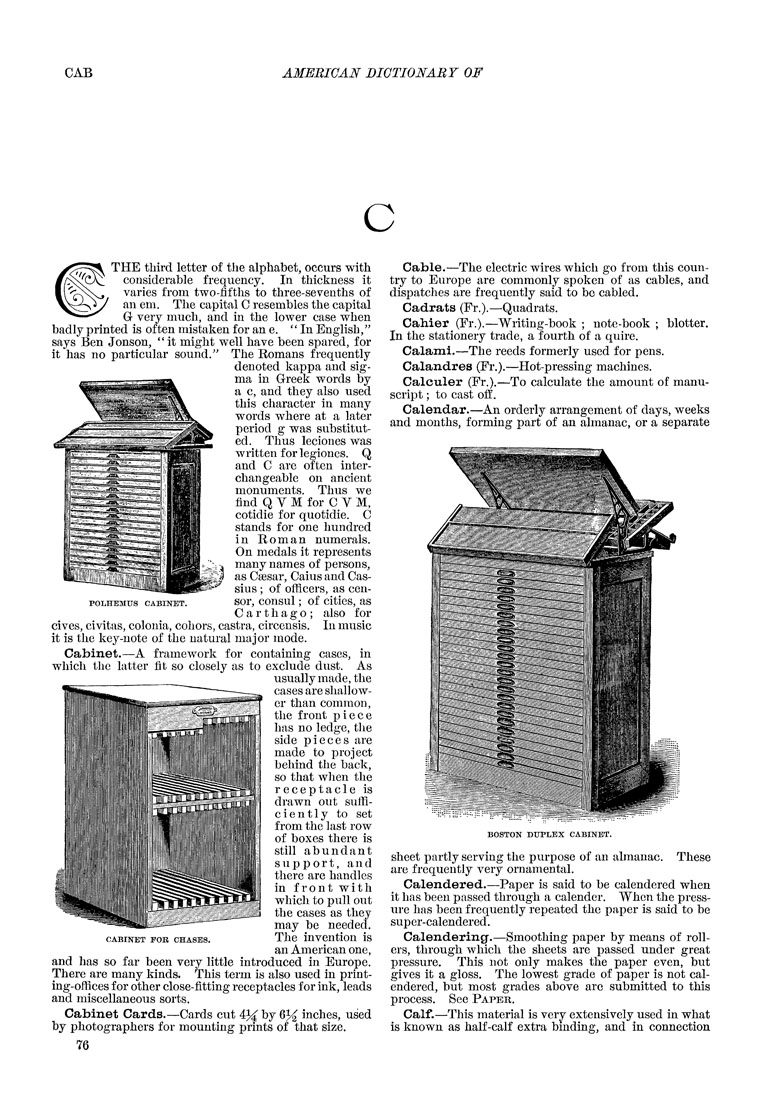CAB
AMERICAN DICTIONARY OF
c
POLHEMUS CABINET.
THE third letter of the alphabet, occurs with
considerable frequency. In thickness it
varies from two-fifths to three-sevenths of
an em. The capital C resembles the capital
G very much, and in the lower case when
badly printed is often mistaken for an e. "In English,"
says Ben Jonson, "it might well have been spared, for
it has no particular sound." The Romans frequently
denoted kappa and sig-
ma in Greek words by
a c, and they also used
this character in many
w^ords where at a later
period g was substitut¬
ed. Thus leciones was
written for legiones. Q
and C are often inter¬
changeable on ancient
monuments. Thus we
find Q V M for C V M,
cotidie for quotidie. C
stands for one hundred
in Roman numerals.
On medals it represents
many names of persons,
as Caesar, Caius and Cas-
sius ; of officers, as cen¬
sor, consul; of cities, as
Carthago; also for
cives, civitas, colonia, cohors, castra, circensis. In music
it is the key-note of the natural major mode.
Cabinet.—A framework for containing cases, in
which the latter fit so closely as to exclude dust. As
usually made, the
cases are shallow¬
er than common,
the front piece
has no ledge, the
side pieces are
made to project
behind the back,
so that when the
receptacle is
drawn out suffi¬
ciently to set
from the last row
of boxes there is
still abundant
support, and
there are handles
in front with
which to pull out
the cases as they
may be needed.
The invention is
an American one,
and has so far been very little introduced in Europe.
There are many kinds. This term is also used in print¬
ing-offices for other close-fitting receptacles for ink, leads
and miscellaneous sorts.
Cabinet Cards.—Cards cut 4J^ by 63^ inches, used
by photographers for mounting prints of that size.
76
CABINET FOR CHASES.
Cable.—The electric wires which go from this coun¬
try to Europe are commonly spoken of as cables, and
dispatches are frequently said to be cabled.
Cadrats (Fr.).—Quadrats.
Cahier (Fr.).—Writing-book ; note-book ; blotter.
In the stationery trade, a fourth of a quire.
Calami.—The reeds formerly used for pens.
Calandres (Fr.).—Hot-pressing machines.
Calculer (Fr.).—To calculate the amount of manu¬
script ; to cast off.
Calendar.—An orderly arrangement of days, weeks
and months, forming part of an almanac, or a separate
BOSTON DUPLEX CABINET.
sheet partly serving the purpose of an almanac. These
are frequently very ornamental.
Calendered.—Paper is said to be calendered when
it has been passed through a calender. When the press¬
ure has been frequently repeated the paper is said to be
super-calendered.
Calendering.—Smoothing paper by means of roll¬
ers, through which the sheets are passed under great
pressure. This not only makes the paper even, but
gives it a gloss. The lowest grade of paper is not cal¬
endered, but most grades above are submitted to this
process. See Papek.
Calf.—This material is very extensively used in what
is known as half-calf extra binding, and in connection
|








